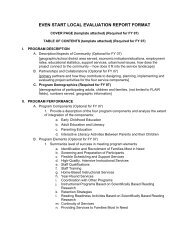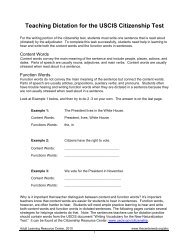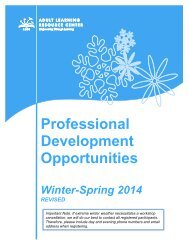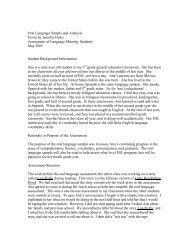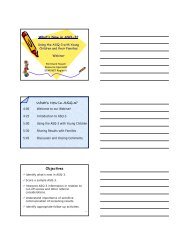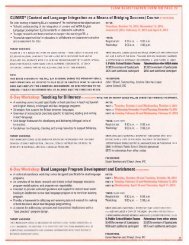Authentic Assessment and Early Childhood Educationâ an Update ...
Authentic Assessment and Early Childhood Educationâ an Update ...
Authentic Assessment and Early Childhood Educationâ an Update ...
You also want an ePaper? Increase the reach of your titles
YUMPU automatically turns print PDFs into web optimized ePapers that Google loves.
“Families of Dual L<strong>an</strong>guage Learners are a particularly<br />
valuable resource in collecting information for authentic<br />
assessment purposes. Parent interviews, questionnaires,<br />
home visits, <strong><strong>an</strong>d</strong> family artifacts add <strong>an</strong> import<strong>an</strong>t<br />
additional dimension for portfolios.”<br />
– Pat Chamberlain<br />
Dual L<strong>an</strong>guage Learners<br />
<strong><strong>an</strong>d</strong> <strong>Authentic</strong> <strong>Assessment</strong><br />
M<strong>an</strong>y early childhood centers in<br />
Illinois serve students for whom English<br />
is a second l<strong>an</strong>guage, <strong><strong>an</strong>d</strong> most<br />
authentic assessment products include<br />
some Sp<strong>an</strong>ish or other non-English<br />
l<strong>an</strong>guage supports. Pat Chamberlain,<br />
former Director of <strong>Early</strong> Learner<br />
programs at District U-46 in Elgin, now<br />
teaches at the Erikson Institute. She<br />
emphasizes that assessment portfolios<br />
should include documents that track<br />
l<strong>an</strong>guage proficiency – in both<br />
l<strong>an</strong>guages if possible. Since a child’s<br />
l<strong>an</strong>guage proficiency varies greatly<br />
based on background, interests,<br />
emotional state, <strong><strong>an</strong>d</strong> experiences,<br />
l<strong>an</strong>guage samples should be collected<br />
across a variety of tasks, partners<br />
(adults <strong><strong>an</strong>d</strong> children), <strong><strong>an</strong>d</strong> settings.<br />
When <strong>an</strong>alyzing English l<strong>an</strong>guage<br />
proficiency in <strong>an</strong> authentic assessment<br />
process, it should be in a way that is<br />
appropriate for young second<br />
l<strong>an</strong>guage learners. Data collection<br />
<strong><strong>an</strong>d</strong> interpretation should be viewed in<br />
culturally <strong><strong>an</strong>d</strong> linguistically responsive<br />
ways. This includes, for Dual<br />
L<strong>an</strong>guage Learners, always<br />
documenting l<strong>an</strong>guage when<br />
reporting progress on curricular goals.<br />
This position was emphasized in 2005<br />
when the National Association for the<br />
Education of Young Children (NAEYC)<br />
<strong><strong>an</strong>d</strong> the National Association of <strong>Early</strong><br />
<strong>Childhood</strong> Specialists in State<br />
Departments of Education (NAECS/<br />
SDE) adopted a supplement to their<br />
Joint Position Statement on <strong>Early</strong><br />
<strong>Childhood</strong> Curriculum, <strong>Assessment</strong>,<br />
<strong><strong>an</strong>d</strong> Program Evaluation.<br />
Keys to Success<br />
as Seen Through the Eyes<br />
of Program Directors <strong><strong>an</strong>d</strong> Classroom Teachers<br />
During the fall of 2011, several Illinois preschool directors <strong><strong>an</strong>d</strong> teachers shared their experiences<br />
with authentic assessment. All strongly agreed that good authentic assessment practice is central<br />
to a preschool teacher’s effectiveness, but each noted particular aspects that were especially<br />
import<strong>an</strong>t to them.<br />
8 Little Prints Volume 6 / Issue 1



